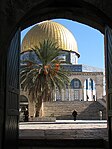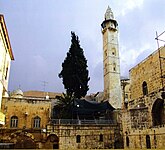
The Temple Mount is a hill in the Old City of Jerusalem that has been venerated as a holy site in Judaism, Christianity, and Islam for thousands of years. It is the site of a large mosque compound known as al-Ḥaram al-Sharīf, al-Aqsa Mosque compound, or simply al-Aqsa Mosque. and sometimes as Jerusalem's sacredesplanade,

Al-Aqsa Mosque, properly Jāmiʿ al-Aqṣā, also known as the Qibli Mosque or Qibli Chapel, is a congregational mosque or prayer hall in the Old City of Jerusalem. In some sources the building is also named al-Masjid al-Aqṣā, but this name and its English translation "Al Aqsa Mosque" itself, is disputed as it can instead apply to the whole compound in which the building sits. The wider compound is also known as the Haram al-Sharif, the Al-Aqsa Mosque compound, and the Temple Mount.
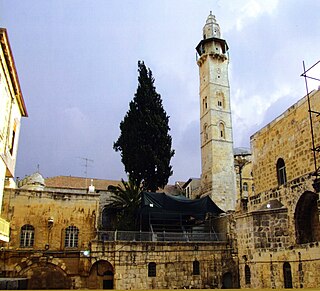
The Ayyubid Mosque of Omar is an Islamic place of worship inside the Old City of Jerusalem. It is located opposite the southern courtyard of the Church of the Holy Sepulchre, in the Muristan area of the Christian Quarter. The mosque is not open to tourists, and can be accessed only for praying.

A khanqah or khangah, also known as a ribat (رباط), is a building designed specifically for gatherings of a Sufi brotherhood or tariqa and is a place for spiritual practice and religious education. The khanqah is typically a large structure with a central hall and smaller rooms on either side. Traditionally, the kahnqah was state-sponsored housing for Sufis. Their primary function is to provide them with a space to practice social lives of asceticism. Buildings intended for public services, such as hospitals, kitchens, and lodging, are often attached to them. Khanqahs were funded by Ayyubid sultans in Syria, Zangid sultans in Egypt, and Delhi sultans in India in return for Sufi support of their regimes.

The holiest sites in Islam are predominantly located in the Arabian Peninsula and the Levant. While the significance of most places typically varies depending on the Islamic sect, there is a consensus across all mainstream branches of the religion that affirms three cities as having the highest degree of holiness, in descending order: Mecca, Medina, and Jerusalem. Mecca's Al-Masjid al-Haram, Al-Masjid an-Nabawi in Medina, and Al-Masjid al-Aqsa, or the Temple Mount, in Jerusalem are all revered by Muslims as sites of great importance.

The Temple Mount, a holy site in the Old City of Jerusalem, also known as the al-Ḥaram al-Sharīf and the al-Aqsa Mosque compound, contains twelve gates. One of the gates, Bab as-Sarai, is currently closed to the public but was open under Ottoman rule. There are also six other sealed gates. This does not include the Gates of the Old City of Jerusalem which circumscribe the external walls except on the east side.
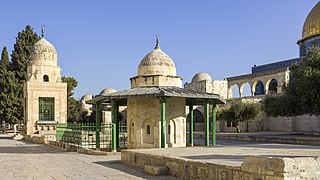
The Fountain of Qasim Pasha is an ablution and drinking fountain in the western esplanade of the al-Aqsa Compound in the Old City of Jerusalem. It is in front of the Chain Gate.

The Dome of the Ascension is a small Islamic free-standing domed structure built by the Umayyads that stands just north the Dome of the Rock on the al-Aqsa compound in Jerusalem.

The Islamic Museum is a museum at Al Aqsa in the Old City section of Jerusalem. On display are exhibits from ten periods of Islamic history encompassing several Muslim regions. The museum is west of al-Aqsa Mosque, across a courtyard.
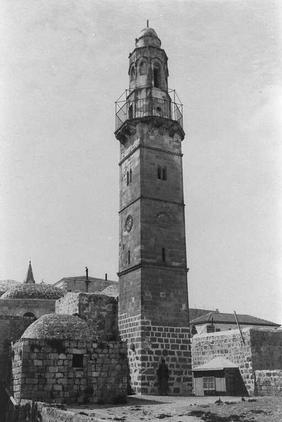
The Al-Khanqah al-SalahiyyaMosque is an Islamic place of worship located in the Christian Quarter of the Old City of Jerusalem, north of the Church of the Holy Sepulchre. It was named after Saladin, who endowed it. As the name indicates, the complex was originally a khanqah, a place for gatherings of Sufi Islamic adherents, including dervishes. The complex today comprises the mosque as well as a school, a public sitting room, rooms for military officers, a dining room for wayfarers, small rooms for guards, and a very small room for Saladin’s spiritual retreat.

Bab Al-Asbat Minaret, Minaret of the Tribes also known as the, is a minaret in Jerusalem. The other name is the Minaret of Salahiyah which is referred to the Salahiyah School close to it. It is one of the four minarets of the Haram al Sharif, and is situated along the north wall.
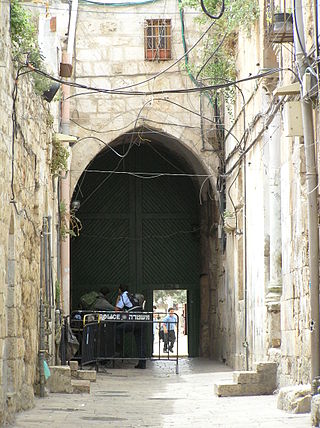
Bāb Ḥuṭṭa is a neighborhood in the Muslim Quarter of the Old City of Jerusalem to the north of Al-Aqsa Compound. The name literally means "Forgiveness Gate", referring to the Remission Gate of the Haram compound, connected by Bāb Ḥuṭṭa Street.

Mamluk architecture was the architectural style that developed under the Mamluk Sultanate (1250–1517), which ruled over Egypt, the Levant, and the Hijaz from their capital, Cairo. Despite their often tumultuous internal politics, the Mamluk sultans were prolific patrons of architecture and contributed enormously to the fabric of historic Cairo. The Mamluk period, particularly in the 14th century, oversaw the peak of Cairo's power and prosperity. Their architecture also appears in cities such as Damascus, Jerusalem, Aleppo, Tripoli, and Medina.

The Al-Aqsa Mosque compound in the Old City of Jerusalem has four minarets in total: three on the western flank and one on the northern flank.

The Inspector's Gate is one of the gates of the al-Aqsa Compound. It is the second-northernmost gates in the compound's west wall, after the Bani Ghanim Gate. It is north of the Iron Gate.
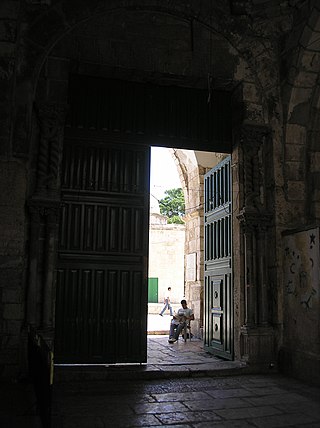
The Chain Gate is one of the gates to the Al-Aqsa Mosque compound on the Temple Mount in the Old City of Jerusalem. It was previously known as David's Gate. As it was named in the early Islamic period Bāb Daud which means David's Gate. It was also known as Bāb al-Maḥkama, named after the nearby Tankiziyya.
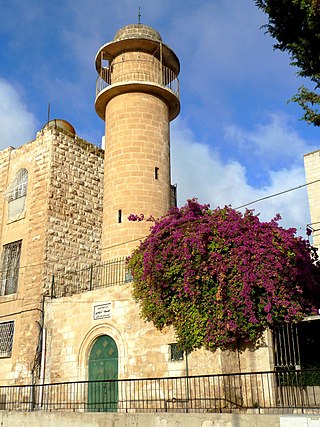
The Al Dissi mosque or the Al Disi mosque is an ancient mosque located within the walls of the Old City of Jerusalem, on the edge between the Armenian Quarter and the Jewish Quarter.
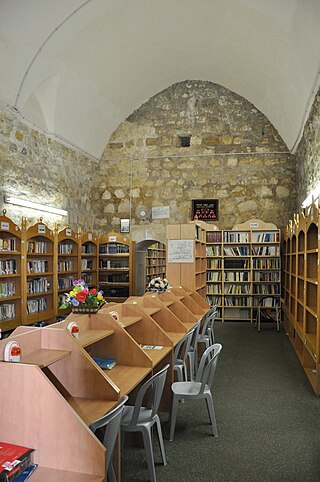
The al-Aqsa Library, also known as the al-Aqsa Mosque Library, is the assemblage of books in the al-Aqsa Compound.





